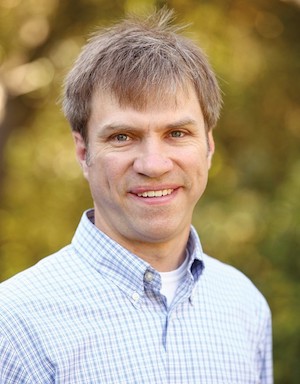Westmont Magazine Finding the Right Equation for Teaching
A Westmont professor uses guided inquiry, an innovative way of teaching, to help students master chemistry.
Michael Everest went to a workshop on pedagogy and decided to try what the presenters suggested. The experience has transformed his teaching.
 Chemistry professors developed a student-centered strategy (POGIL: Process Oriented Guided Inquiry Learning) 20 years ago. Similar to the Socratic method, POGIL involves students seeking answers to questions themselves, creating “a learning cycle of exploration, concept invention and application.” Carefully designed materials guide students as they work in small groups during class to complete challenging assignments.
Chemistry professors developed a student-centered strategy (POGIL: Process Oriented Guided Inquiry Learning) 20 years ago. Similar to the Socratic method, POGIL involves students seeking answers to questions themselves, creating “a learning cycle of exploration, concept invention and application.” Carefully designed materials guide students as they work in small groups during class to complete challenging assignments.
“If I say something, I assume students will misunderstand and not remember,” Michael says. “But if I ask questions and provide materials students can ask questions about, they will remember. Westmont students are great at listening and remembering, but if they come to information on their own, they will understand and recall it better. And they’ll learn more than chemistry—they’ll develop the skill of critical thinking, interpreting data and thinking scientifically.”
Inquiry-based learning suits the chemistry department, where faculty set a high bar for students and provide support to help them succeed. “We consistently interact with students about their work and offer assistance outside of class,” Michael says.
He misses lecturing—he likes talking about what he knows—but he sees it as a barrier to learning. “Lecturing to students gives them a false sense of security,” Michael says. “They see a professor with a doctorate as authoritative. There’s no false sense of security when they have to figure out the answer themselves. They are more active and engaged in their groups, and they say the class goes by quickly. When I start to lecture, I see them disengage.”
For example, Michael gives students a chart so they can learn to interpret it. Questions about its data get progressively more difficult. Students work in groups because individuals would struggle on their own. One student serves as the manager and another as the presenter, and the tasks rotate.
Drawing on his positive experience with guided inquiry, Michael has written a workbook to accompany a textbook by colleague Niva Tro, “Introductory Chemistry.” It provides materials for professors who want to try POGIL in class.
Like all the chemistry faculty, Michael conducts research. In his ongoing project, he’s inventing an instrument for a new technique in measuring things that stick to surfaces. Practical applications of this work could improve contact lenses, kitchen equipment and ocean-going vessels.
A colleague at Santa Barbara City College has asked Michael about an instrument for measuring toxins in poisonous plants at various stages of growth. Intrigued, Michael is focusing on milkweed, which some Native Americans eat. “It’s a great project for students,” Michael says. He has assigned the lab work to a student interested in being a pharmacist.
“What I do in class is conceptual, so it’s great for students to do research and work with their hands,” he says. Two of his student researchers got into top graduate schools: Stanford, UC Berkeley, UC Santa Barbara and Cornell. “I’m impressed by the value the department places on research. We have one of the few undergraduate programs that requires two semesters of research for a Bachelor of Science, and all our majors do research.”
Michael taught at George Fox before coming to Westmont in 2011. He grew up hearing about the value of the liberal arts from his parents, Dan and Sherry Sonneveldt Everest, who both graduated from Westmont. “It’s fun for me to hear students talk about the liberal arts—they even know enough to tell liberal arts jokes at Spring Sing,” Michael says. “I’m no longer the poster child for the liberal arts—they are part of the fabric here. I love students who double major in science and the humanities and faculty who cultivate conversations across disciplinary fences.”